Related Research Articles
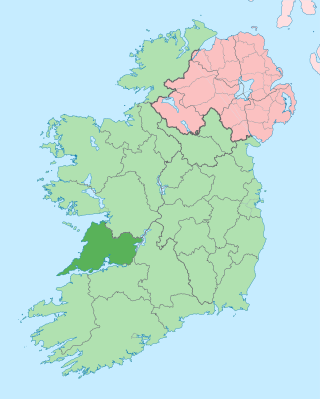
County Clare is a county in Ireland, in the Southern Region and the province of Munster, bordered on the west by the Atlantic Ocean. Clare County Council is the local authority. The county had a population of 118,817 at the 2016 census. The county seat and largest settlement is Ennis.

The Cliffs of Moher are sea cliffs located at the southwestern edge of the Burren region in County Clare, Ireland. They run for about 14 kilometres. At their southern end, they rise 120 metres (390 ft) above the Atlantic Ocean at Hag's Head, and, 8 kilometres to the north, they reach their maximum height of 214 metres (702 ft) just north of O'Brien's Tower, a round stone tower near the midpoint of the cliffs, built in 1835 by Sir Cornelius O'Brien, then continue at lower heights. The closest settlements are the villages of Liscannor 6 km to the south, and Doolin 7 km to the north.
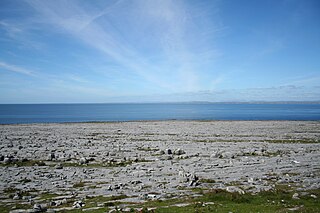
The Burren is a karst/glaciokarst landscape centred in County Clare, on the west coast of Ireland. It measures around 530 square kilometres (200 sq mi), within the circle made by the villages of Lisdoonvarna, Corofin, Gort and Kinvara. The area includes such natural features as Mullaghmore hill and Ailladie cliffs, and historic monuments such as Poulnabrone dolmen and Caherconnell Stone Fort. The Burren National Park covers a small part of the Burren and is the smallest of the six National Parks in Ireland, while the adjacent territory, including the Cliffs of Moher, is included in the Burren and Cliffs of Moher Geopark.

Lisdoonvarna is a spa town in County Clare in Ireland. The town is famous for its music and festivals. Although the music festival was discontinued in the 1980s, Lisdoonvarna still hosts its annual matchmaking festival each September. The population was 829 at the 2016 Census.
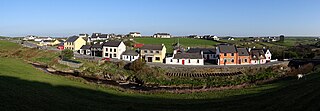
Doolin is a coastal village in County Clare, Ireland, on the Atlantic coast. It is southwest of the spa town of Lisdoonvarna and 4 miles from the Cliffs of Moher. It is a noted centre of traditional Irish music, which is played nightly in its pubs, making it a popular tourist destination. There are numerous nearby archaeological sites, many dating to the Iron Age and earlier. Doonagore Castle and Ballinalacken Castle are also in the area. The area was officially classified as part of the West Clare Gaeltacht prior to the 1950s, and maintains a connection with Irish-speaking areas - including via its maritime connection with the Aran Islands.
Burren can refer to:

Kilfenora is a village and a civil parish in County Clare, Ireland. It is situated south of the karst limestone region known as the Burren. Since medieval times when it was the episcopal see of the Bishop of Kilfenora, it has been known as the "City of the Crosses" for its seven high crosses. The village had around 220 inhabitants in 2011. Much of the TV show Father Ted (1995–98) was filmed there.

Ennistymon or Ennistimon is a country market town in County Clare, near the west coast of Ireland. The River Inagh, with its small rapids known as the Cascades, runs through the town, behind the main street. A bridge across the river leads to nearby Lahinch, on the N67 national secondary road. The town is connected to Ennis by the N85, continuing the settlement's main street.

Lahinch or Lehinch is a small town on Liscannor Bay, on the northwest coast of County Clare, Ireland. It lies on the N67 national secondary road, between Milltown Malbay and Ennistymon, roughly 75 kilometres (47 mi) by road southwest of Galway and 68 kilometres (42 mi) northwest of Limerick. The town is a seaside resort and is home to the Lahinch Golf Club. It has become a popular surfing location.
Liscannor is a coastal village in County Clare, Ireland.

Fanore is a small village in County Clare, on the west coast of Ireland. The area was officially classified as part of the West Clare Gaeltacht, an Irish-speaking community, until 1956.
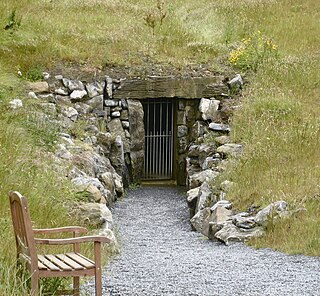
Doolin Cave is a limestone cave near Doolin in County Clare, Ireland, on the western edge of The Burren. The name is the anglicised version of the Irish name Poll an Eidhneáin, which is said to translate into "Ivy Cliff Cave". The cave attracted some controversy due to its development and marketing as a show cave in the early 21st century. It is now open to the public, branded as Doolin Cave.
Father Jerome A. Fahey, (1843–1919), was an Irish priest and writer. Fahey was born at Killomoran, Gort, and educated in the town's national school and St. Jarlath's, Tuam. He studied at St. Patrick's College, Maynooth from 1860, and was ordained there in 1867.

The Burren and Cliffs of Moher Geopark is an internationally designated area of geological interest in The Burren region of County Clare, Ireland. It is the third Geopark to be designated in Ireland, and is recognised at both European and global levels.

Newtown Castle is a 16th-century tower house, located close to the village of Ballyvaughan within the Burren area of County Clare, Ireland. Uniquely for a tower house of its type in Ireland, Newtown Castle is mostly cylindrical in shape but rises from a square pyramidical base. It is today part of the Burren College of Art.

Gleninagh or Glaninagh is a civil parish in County Clare, Ireland. It lies in the extreme northwest of the Burren, on the south of the mouth of Galway Bay. It is known for the well-preserved L-plan Gleninagh Castle, a 16th-century tower house. The parish also contains the lighthouse on Black Head.
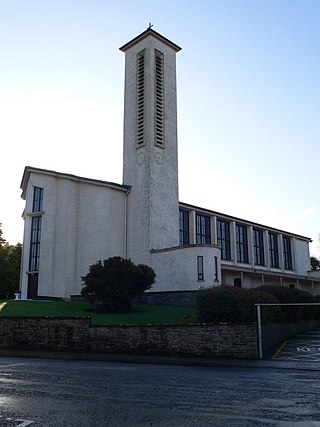
Kilmanaheen is a civil parish in County Clare, Ireland. It contains the market town of Ennistymon.
Máirin de Valéra MRIA was an Irish phycologist. She was the first chair and professor of Botany at University College Galway.
Gleann an Mháma is a glacial valley in County Galway, Ireland. It lies within Joyce Country in Connemara and is part of an aspirant geopark. Much of the valley is in the Connemara Gaeltacht.

Maria Eithne McNamara is an Irish palaeontologist. She is Professor of Palaeobiology at University College Cork.
References
- 1 2 "Burren and Cliffs of Moher Geopark - Meet the team". Archived from the original on 28 January 2018. Retrieved 23 January 2018.
- 1 2 "435 million-year-old starfish discovered". BBC News. 22 January 2018. Retrieved 22 January 2018.
- 1 2 Moonan, Niall (19 January 2018). "Meet the 435million-year-old starfish which lived in an ancient ocean in Galway: Species, named after Dr Eamon Doyle, has remained unchanged for half a billion years" . Retrieved 19 January 2018.
- 1 2 Donovan, S.K., Doyle, E.N. (February 2019). "Utility of crinoid columnals in palaeontology illustrated by a new species: Clare Shale Formation (Carboniferous), Doolin, County Clare, western Ireland". Proceedings of the Geologists' Association. 130 (6): 696–700. doi:10.1016/j.pgeola.2019.02.004. ISSN 0016-7878.
are from a float block of the Clare Shale Formation (Bashkirian stage) at Fisherstreet Bay, Doolin, County Clare ... Heloambocolumnus (col.) harperi gen. et sp. nov.
- 1 2 3 Galway City, Ireland: The Kenny Gallery: Eamon Doyle profile at the Kenny Gallery
- ↑ Ennistymon, Co. Clare, Ireland: CBS Ennistymon, history - Class of 1976 (Eamon Doyle, Paul Doyle listed)
- 1 2 Atlantic Geology: Ron K. Pickerill and the genesis of ichnology in the Antilles, p. 291: "Eamon Doyle was sedimentologist at UWI for four years in the early 1990s ... and contributed to studies of the Richmond Formation and Coastal Group..."
- ↑ New York, NY, USA: Wiley: Albertson, Elizabeth: Ireland for Dummies, 2011, p.334, "...The West Clare Gallery & Studio, on the main street in Ennistymon, is open daily showing gorgeous paintings by Phillip Morrison and Eamon Doyle."
- ↑ West Clare Gallery profile
- 1 2 Award of contract for geological and educational services, Clare Co. Council
- ↑ NUI Galway Official Journal - Lisdoonvarna Integrated Catchment Management Project (4 authors, including Dr Doyle)
- ↑ School of Earth and Ocean Sciences announcements - "The new brittle star fossil is named in honour of former (UCG) Geology undergrad & PhD student, Dr Eamon Doyle who continues to work with @EOS_NUIG The paper documenting this new fossil was edited by Dr John Murray @EOS_NUIG @nuigalway"
- ↑ New York, Irish Central: Storms uncover 7500 year-old drowned forest on Ireland's west coast
- ↑ Clare, Ireland: The Clare Herald, May 2017: 320 million-year-old Shark Tooth Found in Clare
- ↑ Corrib Conservation Centre, 1988: Corrib Country Fossils (Author: Harper, D.A.T., Illustrator: Doyle, E.)